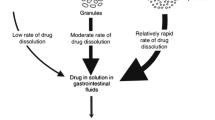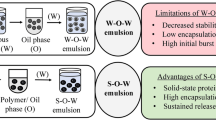Abstract
A formulation containing cellulose acetate phthalate for preparing enteric-coated granules was developed with the use of granulation and microencapsulation techniques. Drug release from tablets or tabletted microcapsules was measured in a disintegration apparatus and an in vitro variable-pH release simulator of the flow type. The release mechanism for the tablets or tabletted microcapsules was determined with the Higuchi matrix model, a first-order kinetic model, and the Weibull distribution function. Adding acetone directly to the mixture of sulfamethoxazole and cellulose acetate phthalate resulted in enteric-coated granules with more prolonged release than other granulation methods. Microencapsulation of the granules significantly delayed the drug release and enhanced the effectiveness of the enteric coating. Microencapsulated granules show release patterns that are sustained and can be simulated with three different release models, i.e., with square-root time plotting, diffusional first-order plotting, and Weibull distribution plotting. The enteric-coating behavior of the tablets was more clearly demonstrated with the variable-pH release simulator than with a fixed-pH dissolution method.
Similar content being viewed by others
REFERENCES
J. Spitael and R. Kinget. Pharm. Ind. 39:502–505 (1977).
S. C. Porter and K. Ridgway. J Pharm Pharmacol. 34:5–8 (1981).
M. Hayashi, T. Nagai, and H. Nogami. Chem. Pharm. Bull. (Tokyo) 18:2350–2353 (1970).
L. Lachman and A. Drubulis. J. Pharm. Sci. 53:639–643 (1964).
A. F. Asker and O. R. Jerbina. Pharmazie 30:186–188 (1975).
H. Takenaka, Y. Kawashima, and S. Y. Lin. J. Pharm. Sci. 69:1388–1392 (1980).
H. Takenaka, Y. Kawashima, and S. Y. Lin. J. Pharm. Sci. 70:1256–1260 (1981).
Y. Kawashima, S. Y. Lin, A. Kasai, H. Takenaka, K. Matsunami, Y. Nochida, and H. Hirosei. Drug Dev. Indust. Pharm. 10:467–479 (1984).
S. Y. Lin, J. C. Yang, and S. S. Jiang. J. Taiwan Pharm. Assoc. (ROC) 37:1–10 (1985).
S. Y. Lin. J. Microencapsul. 2:91–101 (1985).
T. Higuchi. J. Pharm. Sci. 52:1145–1149 (1963).
H. Takenaka, Y. Kawashima, and S. Y. Lin. Chem. Pharm. Bull. (Tokyo) 27:3054–3060 (1979).
B. Hecquet, C. Fournier, G. Depadt, and P. Cappelaere. J. Pharm. Pharmacol. 36:803–807 (1984).
J. T. Carstensen. In L. Lesson and J. T. Carstensen (eds.), Dissolution Technology, Whitlock Press, Washington, D.C., 1974, pp. 188–193.
J. P. Delporte. Pharm. Ind. 41:984–990 (1979).
Author information
Authors and Affiliations
Rights and permissions
About this article
Cite this article
Lin, SY., Kawashima, Y. Drug Release from Tablets Containing Cellulose Acetate Phthalate As an Additive or Enteric-Coating Material. Pharm Res 4, 70–74 (1987). https://doi.org/10.1023/A:1016442330193
Issue Date:
DOI: https://doi.org/10.1023/A:1016442330193




